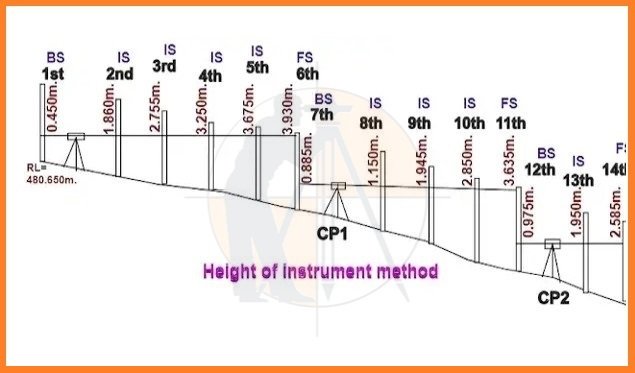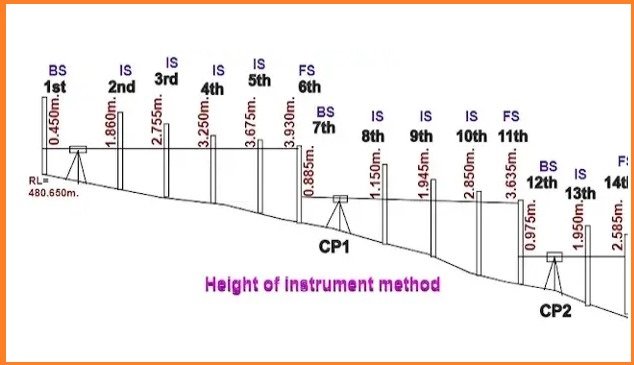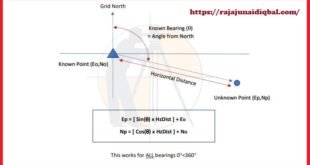How to Calculate the RL by HI Method in Surveying.
In this article i will explain how to Calculate the RL by HI method in surveying, Let us consider an example as given below.
The leveling instrument was used to observe the subsequent readings.
0.450, 1.860, 2.755, 3.250, 3.675, 3.930, 0.885, 1.150, 1.945, 2.850, 3.635, 0.975, 1.950, & 2.585. The instrument was shifted after the Sixth and Eleventh readings. The elevation of the first reading was 480.65m. Calculate the RL of all the points by using the Height of instrument method.

Calculation.
As u can observe in the above drawing, the instrument is shifted after the Sixth and Eleventh reading.
So, first, seventh, and twelfth readings 👉 BS
Sixth, Eleventh, and 14th readings 👉 FS &
All of other remaining readings 👉 IS
Learn More
What is the Components of Road structure
How To Convert the Bearings and Distances to Coordinates
Please remember:
👉 While Surveying, the first reading becomes BS and the last reading becomes FS.
Note:
-
BS 👉 backsight.
-
FS 👉 foresight.
-
IS 👉 intermediate sight.
-
CP 👉 change point.
-
HI 👉 height of instrument.
-
RL 👉 reduced level.
Now, let us prepare the Height of the instrument table from the above-mentioned data.
Following are the rules or formulas u should remember while calculating the RL in the height of the instrument method.
1 – HI = [RL + BS]
Whenever u get the BS reading, u have to calculate the height of the instrument in that particular change point. By adding the RL to the BS u will get the HI when u establish the instrument in the new change point.
2 – RL = [HI – IS or FS]
Once the height of the instrument is calculated, u have to deduct the IS & FS from the HI to calculate the RL of that particular station. This procedure should be continued until u get the new HI at the change point.
Keeping in mind, the above given formulas, let us start the calculation procedure.
-
First HI = [1st given RL + 1st BS] = [480.65 + 0.45] = 481.10
-
Second RL = [1st HI – First IS] = [481.10 – 1.860] = 479.240
-
Third RL = [1st HI – Second IS] = [481.10 – 2.755] = 478.345
-
Forth RL = [1st HI – Third IS] = [481.10 – 3.250] = 477.850
-
Fifth RL = [1st HI – Forth IS] = [481.10 – 3.675] = 477.425
-
Sixth RL = [1st HI – First FS] = [481.10 – 3.930] = 477.170
As u can observe in the below-given table, the IS And FS is deducted from the same HI until u shift the instrument & note down the new BS reading.
Learn More
Interview Question and Answer For Land Surveying
Civil Engineering Basic Knowledge
What is The Contour Mapping
Types Of Curves In Surveying Work
Once u note down the BS reading for the change point, again u have to calculate the HI And by adding RL to the BS.
-
Second HI = [ 6th RL + 2nd BS] = [477.170 + 0.885] = 478.055
-
7th RL = [2nd HI – Fifth IS] = [478.055 – 1.150] = 476.905
-
8th RL = [2nd HI – Sixth IS] = [478.055 – 1.945] = 476.110
-
9th RL = [2nd HI – Seventh IS] = [478.055 – 2.850] = 475.205
-
10th RL = [2nd HI – Second FS] = [478.055 – 3.635] = 474.420
Again calculate HI for the 3rd BS
-
Third HI = [ 10th RL + Third BS] = [474.420 + 0.975] = 475.395
-
Eleventh RL = [3rd HI – Eighth IS] = [475.395 – 1.950] = 473.445
-
Twelfth RL = [3rd HI – Third FS] = [475.395 – 2.585] = 472.810
All the calculated values should be entered as shown in the below-given table.
Station |
BS |
IS |
FS |
HI |
RL |
Remark |
| 1 | 0.450 | 481.10 | 480.650 | BM | ||
| 2 | 1.860 | 479.240 | ||||
| 3 | 2.755 | 478.345 | ||||
| 4 | 3.250 | 477.850 | ||||
| 5 | 3.675 | 477.425 | ||||
| 6 | 0.885 | 3.930 | 478.055 | 477.170 | CP1 | |
| 7 | 1.150 | 476.905 | ||||
| 8 | 1.945 | 476.110 | ||||
| 9 | 2.850 | 475.205 | ||||
| 10 | 0.975 | 3.635 | 475.395 | 474.420 | CP2 | |
| 11 | 1.950 | 473.445 | ||||
| 12 | 2.585 | 472.810 | ||||
| Total Ʃ | 2.310 | 10.150 |
Arithmetic check
[∑FS – ∑BS] = [First RL – last RL] [∑FS – ∑BS] = [ 10.150 – 2.310] = 7.840 ✔ [First RL – last RL] = [ 480.650 – 472.810] = 7.840 ✔Hence, the calculation is the correct.

 Surveying & Architects A unique platform of Civil Engineering
Surveying & Architects A unique platform of Civil Engineering
